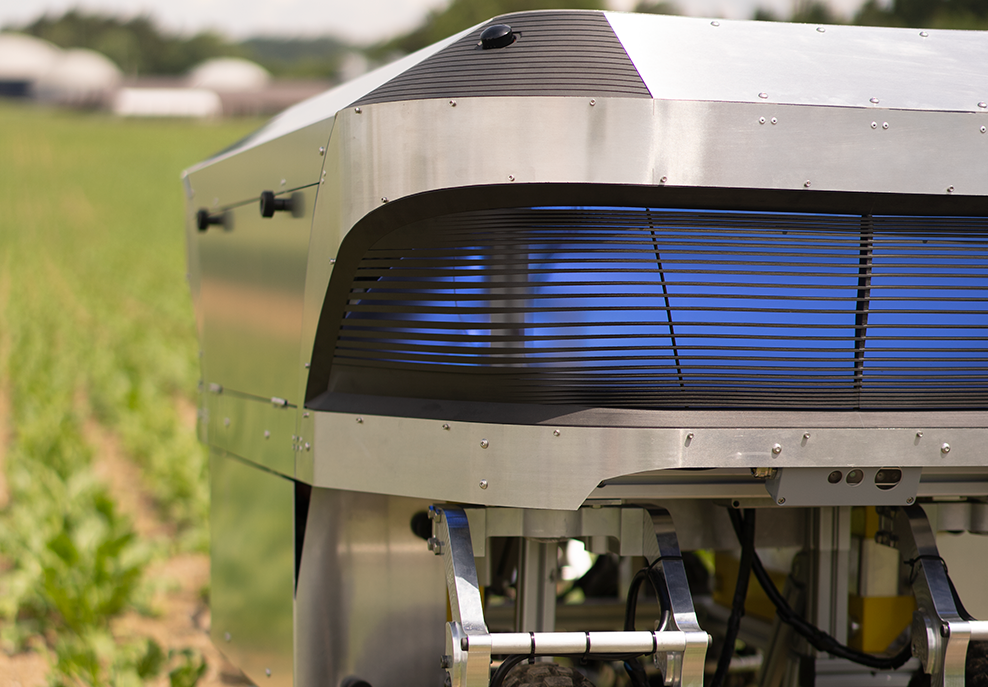Engineering company Scheurer Swiss GmbH has used its 3D printing expertise to help a group of ETH Zürich students develop their “Rowesys” automated robotic weeding system.
Working with the Zurich team, Scheurer Swiss supplied and produced several 3D printed carbon-reinforced components, which enabled the robot’s construction, and enhanced its performance. The compact weed killing bot, which is now entering final testing, has been designed as a sustainable alternative to the use of environmentally-damaging herbicides in agricultural farming.
“We supported the Rowesys team with our know-how in the field of fibre composite technologies in an advisory capacity. Operationally, we incorporated our many years of expertise from the development of highly efficient composite components for motor sports, into the development and 3D printing of the carbon-reinforced components for the agricultural robot,” said Dominik Scheurer, CEO of Scheurer Swiss GmbH.
Additive solutions to environmental problems
While herbicides offer a time and cost-effective weed killing solution to farmers, their use has increasingly been linked to environmental damage. In Switzerland for instance, measurements have shown contaminated ground water in almost all regions containing agriculture. Currently the only viable alternative approach to conventional farming, is opting to go organic instead. This farming technique is more sustainable, but requires additional work, and can often drive up consumer prices while lowering customer demand. As a result, what was needed in the eyes of the Zurich team, was a new herbicide-free and economically-viable solution.
Enter the robotic weed killer. The Rowesys autonomous weeding robot uses vision sensors to identify and destroy weeds, without the need to overuse herbicides. Created by a team of ten highly motivated students, eight expert coaches and their sponsors Scheurer Swiss, the bot represents a user-friendly and efficient weed killing solution. Moreover, the project demonstrates how damage to the environment can be minimised with the implementation of digitisation and 3D printing technology.
“What motivated me about this project, apart from the relevance of what I learned and the chance to gain practical experience in teamwork, was the sustainability of herbicide-free sugar beet cultivation,” said Nico Burger, Software & Controls Team Rowesys. “Because up to now, there has been no investment in more sustainable production in this area of agriculture.”

Project Rowesys: 3D printing the weed killer
As a gold sponsor of the research group, Scheurer Swiss offered its engineering expertise to the team, and 3D printed carbon-reinforced components for the robot on their behalf. 3D printing these parts not only provided cost efficiency and design flexibility benefits, but enabled the group to meet the robot’s reliability, autonomy and safety requirements as well.
For example, the agricultural robot features 3D printed wafer-thin carbon-reinforced plastic slats that are backed by LEDs, indicating the robot’s status at all times, and allowing the team to work safely around it. The autonomous weed killer also uses a 3D printed lattice-like part, which serves as an interface between the aluminium chassis and the robot’s electronics. Using AM, the unusual shape of the connector can be produced in such a way that not a single gram of superfluous material is used.
Not only does this keep the robot lightweight and add to its sustainability credentials, but the component remains ultra-stable during use, enabling it to maintain the connection during use. “Only with the technology of carbon-reinforced 3D printing is it even possible to produce such a precisely fitting, filigree and yet stable component,” added Scheurer.
In the final product, the agricultural bot is capable of pulling small ploughs through the soil, which destroys the weeds between the rows of plants, by pulling the roots up to the surface. In addition, the robot is able to drive autonomously, detect the end of the field with the help of its built-in cameras, and switch to the next untilled row. Following initial testing which involved sugar beet farming, the bot was found to be capable of repeating the process, while dramatically reducing the amount of pollution caused by using harmful herbicides.
“The focus project Rowesys is an example of how digitisation and the use of innovative materials can produce efficient and intelligent technical achievements,” concluded Scheurer. “We congratulate the Rowesys team on their success and are pleased that we were able to support the team with our expertise in an advisory and operational capacity right up to the practical test.”

ETH Zurich’s additive innovations
In the last year alone, researchers from ETH Zurich have used 3D printing to enhance the qualities of a wide variety of end-use materials. In June 2020 for instance, a Zurich research team developed a novel universal nanocarrier ink platform, which facilitated the formulation of biofunctional inks. Applications for the material’s unique customized biofunctionality, included tissue engineering and drug delivery, as well as advanced biomaterials.
In December 2019 meanwhile, Swiss-based scientists successfully 3D printed glass objects using a specialized resin and Digital Light Processing (DLP). The method proved capable of creating complex glass parts, with high spatial resolutions and multi-oxide chemical compositions.
Similarly, in August 2019, a different group of Zurich researchers developed an additive manufacturing-based procedure to make magnesium scaffolds with regular porosity. Using a 3D printed salt template, the team’s method managed to create magnesium structures with ordered pores while retaining their mechanical stability.
You can now nominate for the 2020 3D Printing Industry Awards. Cast your vote to help decide this year’s winners.
To stay up to date with the latest 3D printing news, don’t forget to subscribe to the 3D Printing Industry newsletter or follow us on Twitter or liking our page on Facebook.
Looking for a job in the additive manufacturing industry? Visit 3D Printing Jobs for a selection of roles in the industry.
Featured image shows the Zurich team’s automated robotic weed removal system in action. Image via Rowesys.


